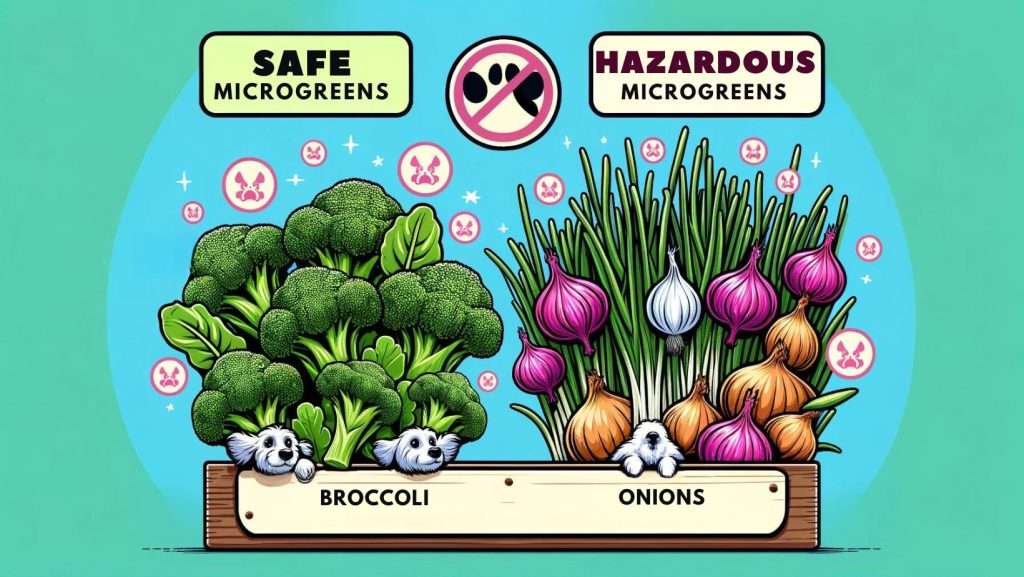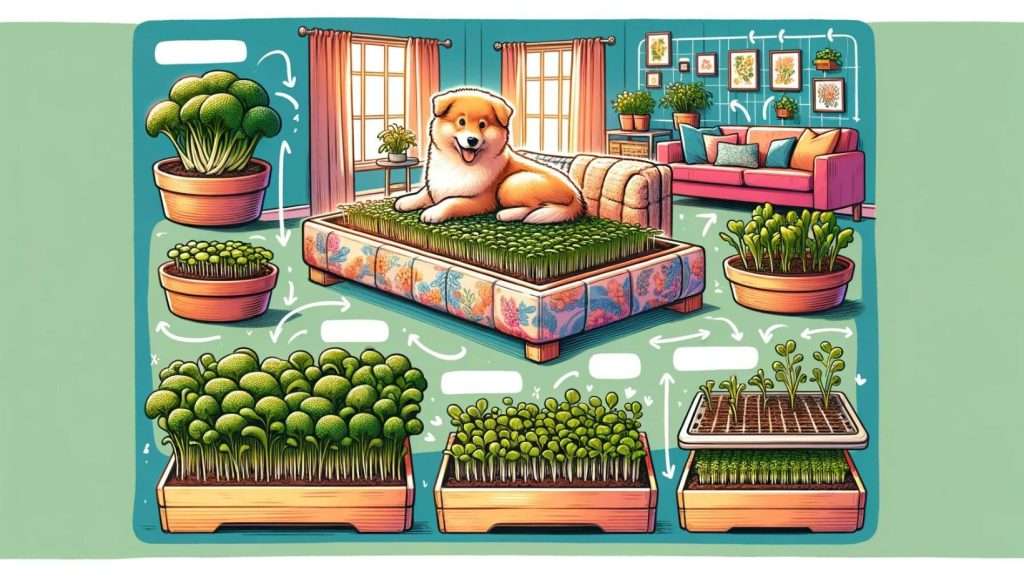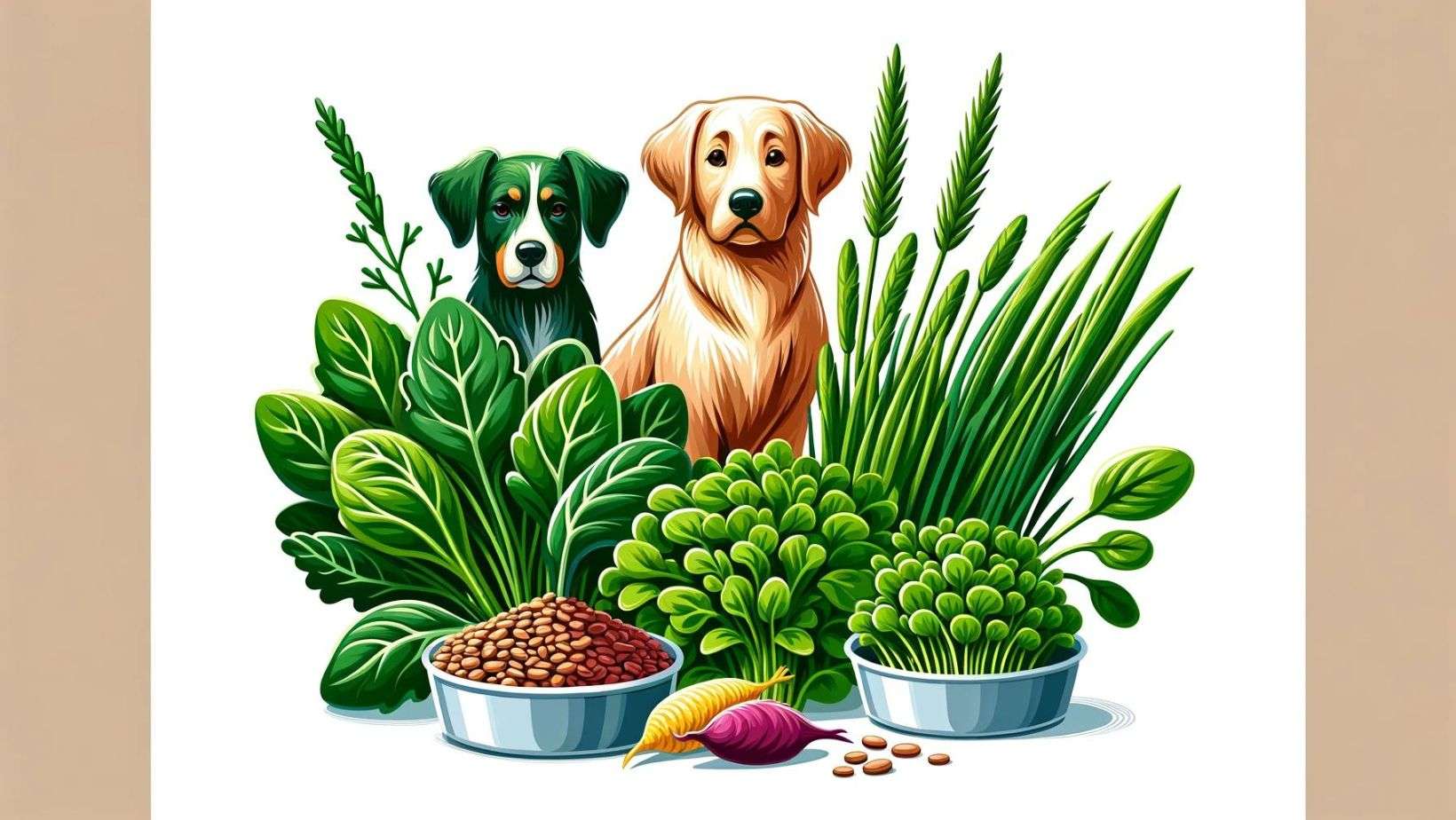Microgreens For Dogs: The Key to Unlocking Superior Canine Nutrition
Some of our posts on Microgreensguru.com contain affiliate links. If you click on an affiliate link and make a purchase, we may receive a commission. Clicking on an affiliate link that earns a commission does NOT result in additional charges or costs you extra. Earnings from affiliate links help keep this website running. See our full affiliate disclosure here.
Microgreens for dogs? You might be thinking, “Wait, what?” You love your dog more than anything, right?
And you’d do just about anything to keep them healthy and happy. But have you ever considered adding these tiny, nutrient-packed greens to their diet?
Now, I know what you’re thinking – “Aren’t those just fancy garnishes for my salad?” Nope, not even close. These mini-veggies pack a serious nutritional punch that could transform your pup’s well-being.
Skeptical?
I was too, until I did some digging and discovered just how incredible microgreens really are for our furry friends.
So, What Exactly Are Microgreens?
Picture this: you’ve got your regular, fully-grown veggies and herbs, right?
Now, imagine harvesting them when they’re just a few weeks old, still tiny and tender. That’s what microgreens are – the baby versions of your favorite greens, packed with flavor and nutrition.
These little guys are like superheroes in the plant world. They’ve got way more vitamins, minerals, and antioxidants than their grown-up counterparts. It’s like they’re wearing tiny capes, ready to swoop in and save the day (or, in this case, your dog’s health).

Are Microgreens Safe for Your Furry Friend?
I get it. You’re probably wondering if it’s okay to feed your dog something that sounds like it belongs in a fancy salad. The good news is that most microgreens are perfectly safe for your pooch. However, as with any new food, it’s always a good idea to introduce them gradually and keep an eye out for any potential allergies or tummy troubles.
Now, there are a few microgreens you’ll want to avoid, like onions, garlic, and chives. These can be toxic to dogs and mess with their red blood cells. So, just like you wouldn’t feed your dog a slice of pizza with garlic and onions (no matter how much they beg), steer clear of these microgreens, too.
As a rule of thumb, I always recommend checking with your vet before making any significant changes to your dog’s diet. They know your pup best and can give you personalized advice based on their unique needs.
As with any change to your dog’s diet, consult with your veterinarian before adding microgreens to your little one’s meals. Microgreens are generally safe for dogs and can provide them with valuable nutrients, but it’s always best to check with a professional first.
Why Microgreens Are a Doggy Superfood
Alright, now that we’ve covered the basics, let’s dive into why microgreens are like the Superman of dog food:
1. They’re Nutrient Powerhouses
Remember how I said microgreens are packed with nutrients? I wasn’t kidding. These tiny greens can have up to 40 times more vitamins and antioxidants than their mature counterparts. That’s like giving your dog a multivitamin in every bite!
2. They Keep Things Moving (If You Know What I Mean)
Microgreens are loaded with fiber, which is essential for keeping your dog’s digestive system running smoothly. Think of it as a natural broom, sweeping away any unwanted stuff and promoting healthy bowel movements. Plus, fiber helps your dog feel full and satisfied, which can be a lifesaver if they’re watching their waistline.
3. They Boost Your Dog’s Immune System
Antioxidants are like the bodyguards of your dog’s cells, protecting them from damage caused by pesky free radicals. Microgreens, especially those from the brassica family (like broccoli and kale), are bursting with these powerful compounds. A strong immune system means your dog is better equipped to fight off diseases and stay in tip-top shape.
4. They’re Heart-Healthy
Just like us, our dogs can benefit from heart-healthy nutrients. Microgreens like kale and spinach are rich in vitamins and minerals that support cardiovascular health. Vitamin K, for example, helps keep blood clotting in check, while potassium and magnesium work together to maintain healthy blood pressure. It’s like giving your dog’s heart a big, leafy green hug.
5. They May Help Prevent Cancer
Now, I know the C-word is scary, but hear me out. Some microgreens, particularly those from the cruciferous crew (think broccoli and cabbage), contain a compound called sulforaphane. This little guy is like a superhero in disguise, with impressive anti-inflammatory and cancer-fighting abilities. While more research is needed, adding these microgreens to your dog’s diet may help reduce the risk of certain cancers.

The Top Microgreens for Your Top Dog
By now, you’re probably eager to start adding microgreens to your dog’s bowl. But with so many options out there, which ones should you choose? Here are some of the best microgreens for your canine companion:
1. Kale
Kale is like the king of microgreens, packed with vitamins A, C, and K, as well as calcium and iron. It’s also got this cool compound called sulforaphane, which has some serious anti-inflammatory and cancer-fighting properties.
2. Spinach
Popeye was onto something with his love for spinach. These microgreens are loaded with vitamins A and C, folate, iron, and calcium. Plus, they’ve got antioxidants like lutein and zeaxanthin, which are important for maintaining healthy eyes.
3. Wheatgrass
Wheatgrass is like a natural detox for your dog. It’s full of chlorophyll, which helps support liver function and flush out toxins. Plus, it’s got vitamins A, C, and E, as well as iron and calcium.
4. Sunflower
These sunny microgreens are not only tasty but also packed with protein, vitamin E, and B vitamins like folate and niacin. They’ve also got some awesome plant compounds like chlorophyll and polyphenols.
Feeding Microgreens to Your Dog: Tips and Tricks
Now that you know which microgreens to look for, let’s talk about how to actually get them into your dog’s diet. Here are a few simple ways to incorporate these tiny greens into your pup’s meals:
1. Sprinkle Them on Top
One of the easiest ways to add microgreens to your dog’s diet is to simply sprinkle a small amount on top of their regular food. This works great for dogs who might be a bit hesitant to try new things, as the familiar taste and smell of their food can help mask any new flavors.
2. Mix Them into Homemade Meals
If you’re a fan of whipping up homemade meals for your dog, microgreens are a breeze to incorporate. Just chop or blend the greens and mix them into the food before serving. It’s like adding a secret superfood ingredient to your dog’s favorite dish.
3. Offer Them as Treats
Some dogs (like mine) are always up for trying new things, especially when it comes to treats. You can offer a small handful of microgreens as a reward during training sessions or as a healthy midday snack. Just remember to start with small amounts and gradually increase over time.
Growing Your Own Microgreens: A Fun and Rewarding Project
As a microgreens guru and dog lover, I can’t recommend growing your own greens enough. Not only is it a fun and rewarding hobby, but it also lets you control the quality and freshness of the greens you feed your dog.
Don’t worry; you don’t need a green thumb or a bunch of fancy equipment to get started. Here’s a quick rundown of the process:
- Pick your seeds: Go for high-quality, organic seeds from trusted suppliers. Avoid any treated or coated seeds, as they may contain harmful chemicals.
- Prep your growing tray: Fill a shallow tray with an inch or two of organic potting soil or a special microgreen growing mat.
- Plant the seeds: Sprinkle the seeds evenly over the surface of the soil or mat, then gently press them in to ensure good contact.
- Water and cover: Give the seeds a good misting with water and cover the tray with a clear lid or plastic wrap to keep things nice and moist.
- Let there be light: Once the seeds have sprouted, remove the cover and place the tray in a sunny spot or under grow lights.
- Harvest time: When your microgreens have reached 1-3 inches in height (usually within 1-2 weeks), they’re ready to harvest. Just snip the greens right above the soil line, give them a rinse, and they’re good to go.
Potential Risks and Side Effects
While microgreens are generally safe for dogs, there are a few things to keep in mind:
- Upset tummies: Some dogs might experience digestive issues when first trying microgreens, usually because of the high fiber content. To avoid this, start with small amounts and gradually increase the portion size.
- Allergic reactions: In rare cases, dogs can develop an allergic reaction to certain microgreens. Watch out for symptoms like itching, swelling, or difficulty breathing. If you notice any of these, stop feeding the microgreens and check in with your vet.
- Medication interactions: Some microgreens, like spinach and kale, are high in vitamin K, which can interfere with blood-thinning medications. If your dog is on any meds, it’s best to consult with your vet before adding microgreens to their diet.
Storing and Preserving Your Microgreens
To make sure your dog gets the most out of their microgreens, it’s important to store and preserve them properly:
- Refrigeration: After harvesting, place the microgreens in a clean, airtight container and store them in the fridge. They should stay fresh for 5-7 days.
- Freezing: If you’ve got extra microgreens, you can freeze them for later use. Blanch them in boiling water for 30 seconds, then transfer them to an ice bath. Drain, pat dry, and place them in a freezer-safe container. Frozen microgreens can be stored for up to 6 months.
- Dehydration: Another option is to dehydrate your microgreens. Spread them out on a dehydrator tray and dry them at 115°F (46°C) for 4-6 hours, or until they’re crispy. Store the dehydrated microgreens in an airtight container in a cool, dry place. They should stay fresh for up to a year.
Cost-Effectiveness of Growing Your Own Microgreens
Growing your own microgreens can be a cost-effective way to provide your dog with fresh, nutrient-dense greens. Here’s a breakdown of the potential costs:
- Seeds: A packet of microgreen seeds typically costs between $3 and $10, depending on the variety and quantity. One packet can yield several trays of microgreens. I like microgreen seeds from True Leaf Market.
- Growing trays: Shallow growing trays can be purchased for around $5 to $15 each, or you can repurpose containers you already have at home.
- Potting soil: A bag of organic potting soil costs approximately $10 to $20 and can be used for multiple growing cycles.
- Water and electricity: The cost of water and electricity for growing microgreens is minimal, as they require only a small amount of each.
In comparison, a 4-ounce package of pre-grown microgreens from a specialty store can cost $5 to $10. By growing your own microgreens, you can save money in the long run while ensuring that your dog receives the freshest, highest-quality greens possible.

Preparing Microgreens for Your Dog
Preparing microgreens for your dog is a simple process that requires minimal time and effort. Here’s a step-by-step guide:
- Harvest: Once your microgreens have reached 2-3 inches in height, use clean scissors to cut them just above the soil level.
- Rinse: Gently rinse the microgreens under cool running water to remove any dirt or debris.
- Dry: Pat the microgreens dry with a clean towel or use a salad spinner to remove excess water.
- Chop or blend: Depending on your dog’s preferences, you can either chop the microgreens into smaller pieces or blend them into a fine puree.
- Mix with food: Add the chopped or blended microgreens to your dog’s regular food, starting with a small amount and gradually increasing the portion size over time.
By following these simple steps, you can easily incorporate microgreens into your dog’s diet and provide them with a nutrient-dense boost to their daily meals.
Environmental Benefits of Growing Your Own Microgreens
Growing your own microgreens isn’t just great for your dog’s health; it’s also good for the planet! Here’s how:
- Reduced carbon footprint: By growing your own microgreens, you eliminate the need for transportation and packaging, which can significantly reduce the carbon footprint associated with store-bought greens.
- Less water usage: Microgreens require much less water than full-grown vegetables, making them a more sustainable choice for environmentally conscious pet owners.
- Minimal space requirements: Microgreens can be grown in small, indoor spaces, such as windowsills or countertops, reducing the need for large outdoor gardens or agricultural land.
- Reduced food waste: By growing only what you need and harvesting microgreens at their peak freshness, you can minimize food waste compared to purchasing pre-packaged greens that may spoil before they are consumed.
By choosing to grow your own microgreens, you not only provide your dog with fresh, nutrient-dense greens but also contribute to a more sustainable and environmentally friendly lifestyle.
Key Takeaways
- Microgreens are nutrient-dense, tiny versions of veggies and herbs that pack a serious nutritional punch for your pooch.
- Most microgreens are safe for dogs, but avoid onions, garlic, chives, and any spicy or pungent varieties.
- Microgreens offer a wide range of health benefits for dogs, including boosting their immune system, supporting digestive health, and even potentially reducing the risk of certain cancers.
- Kale, spinach, wheatgrass, and sunflower microgreens are some of the best options for dogs.
- You can easily incorporate microgreens into your dog’s diet by sprinkling them on top of their food, mixing them into homemade meals, or offering them as treats.
- Growing your own microgreens is a fun, rewarding, and cost-effective way to provide your dog with fresh, nutrient-dense greens.
- Proper storage and preservation techniques can help ensure your dog gets the most out of their microgreens.
- Growing your own microgreens also has environmental benefits, such as reducing your carbon footprint and minimizing food waste.
Frequently Asked Questions
- Can microgreens replace my dog’s regular diet? No, microgreens should not replace your dog’s regular diet. They should be used as a supplement to provide additional nutrients and health benefits.
- How much microgreens should I feed my dog? As a general guideline, microgreens should make up no more than 5-10% of your dog’s total diet. Start with small amounts and gradually increase the portion over time.
- Can I feed my dog microgreens every day? Yes, you can feed your dog microgreens daily, as long as they are introduced gradually and make up a small portion of their overall diet.
- Are microgreens safe for puppies? It’s best to wait until your puppy is fully weaned and eating solid food before introducing microgreens. Always start with small amounts and consult with your veterinarian if you have any concerns.
- Can microgreens help with my dog’s specific health issues? While microgreens offer a wide range of health benefits, it’s essential to consult with your veterinarian regarding your dog’s specific health concerns. They can provide personalized advice on how to incorporate microgreens into your pet’s diet for optimal results.
The Bottom Line
Microgreens are a fantastic way to give your dog’s diet a nutritional boost. By choosing safe and appropriate varieties, introducing them gradually, and keeping an eye out for any adverse reactions, you can help support your furry friend’s overall health and well-being.
Whether you decide to buy microgreens from a trusted supplier or grow your own at home, these tiny greens are sure to make a big impact on your dog’s health. As always, it’s a good idea to chat with your vet before making any major changes to your dog’s diet, just to be on the safe side.
So, why not give microgreens a try? Your dog will thank you for it (probably with lots of tail wags and sloppy kisses).
And who knows? You might even find yourself sneaking a few into your own salads.

Cal Hewitt is the Founder and Lead Cultivator at Microgreens Guru, a website dedicated to empowering individuals to grow, consume, and potentially sell nutrient-dense microgreens. With 5 years of hands-on experience in microgreens cultivation, Cal brings a unique analytical perspective to the world of urban agriculture. He specializes in optimizing growth techniques for various microgreen varieties, while also focusing on sustainable and cost-effective growing methods. Cal’s passion for microgreens, ignited by a personal health journey, drives him to continuously explore and share innovative approaches to microgreens cultivation. His practical experience, combined with his commitment to education through his website and upcoming book, ensures that Microgreens Guru remains a valuable resource for both novice and experienced growers alike.






